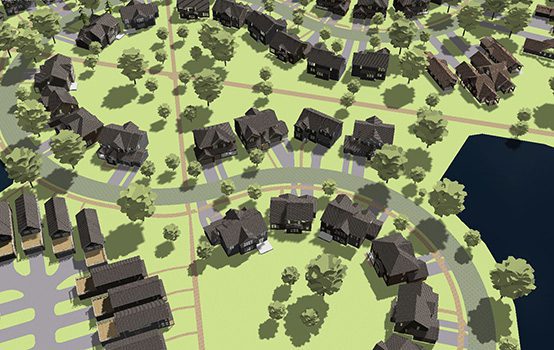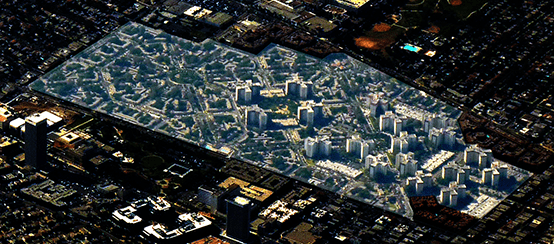Urban Growth and the Fallacy of Control

I live in one of the faster-growing cities in one of the fastest-growing states in America. A common joke here in Florida is that the state bird is the crane. (Get it?) Needless to say, growth is a contentious and emotional subject around here. And growth control is a hot topic.
And rightly so. Rapid growth can be disorienting and detrimental to the existing residents of a place—traffic jams where they didn’t used to occur, crowded schools and hospitals. It’s not at all clear, despite conventional wisdom, that growth itself should be viewed as any sort of measure of success or prosperity. Plenty of growing places aren’t thriving, and plenty of thriving places aren’t growing. (A particularly salient point in Florida, where our population growth is largely driven by low-wage jobs.)
And at Strong Towns, where I work, we have long pointed out that plenty of growth looks more like a Ponzi scheme than like real, resilient wealth. Think spread-out, low-value development that fails to pay for itself, leaving the next generation on the hook for this generation’s overbuilt infrastructure.
But there’s one particular line of argument when it comes to managing growth that I simply can’t get behind. It’s the notion that whether or not to grow, or precisely how much to grow—how many people to let in—is something that a community should naturally get to decide through the political process. That they maybe even have an inalienable right to decide.
It’s certainly not just a Florida preoccupation. “More than a million people in San Francisco? Did anyone ask you?” inquired a prominent Bay Area activist in a blog post a couple years ago. Growth-control advocates in Boulder, Colorado muse about “carrying capacity” and overpopulation. Here in Gulf-coast Florida, the preferred pejorative is “Browardization,” after Broward County on the state’s Atlantic coast—held up by growth-control partisans as a warning of our grim fate if we don’t slow our population growth.
The approval of locally unpopular development proposals, to hear many here tell it, constitutes a betrayal of the public interest by our own elected officials. Slow-growth appeals are usually accompanied by calls for development to be orderly, predictable, and always, always the favored buzzword: “compatible” with surrounding neighborhoods. None of this sounds objectionable on paper. Who would be against compatibility?
And yet, here’s why this doesn’t always sit right with me.
The actual outcomes on the ground of successful growth-control advocacy are often not very pretty. Whether in Boulder, Austin, San Francisco, Seattle, or Sarasota, those who claim we can keep existing neighborhoods under glass; restrain the pace of growth to only that which makes us comfortable; and preserve affordability, economic opportunity, and quality of life, and do these difficult things all at the same time—well, these people are indulging an illusion.
A city is a complex system. It’s made up of thousands or millions of people making billions or trillions of decisions, in endless, fractal feedback loops. The city is not a machine; it’s more like an ecosystem. You can tinker with an ecosystem—but when you do, you’re subject to the law of unintended consequences.
The Water Has To Go Somewhere
One such consequence, when it comes to growth-control policies, is that you may simply displace growth to another location—without actually lessening any of its disruptive effects. In the process, you may even prevent some people from living and/or working where they otherwise would have preferred to—and in doing so, prevent the market signals from functioning that would have otherwise told us what is a productive and desirable location.
Many growth critics seem to operate with a flawed mental model that, rather circularly, treats development itself as the cause of population growth. Let the builders build, and the city gets more crowded and the traffic gets worse. Don’t let them build so much, and growth will slow down and traffic will thin out. Easy, right?
Instead, think of demand to live and work in a place like the water in a river. Building a dam across the river, or channelizing it, doesn’t make the water go away. The water has to go somewhere. It might rush around the dam. It might overflow the dam, or pool behind it. But it’ll go somewhere.

Marin County, California, just north of San Francisco, is perhaps the most famous poster child for this. Thanks to powerful environmental advocacy, especially in the 1960s and 1970s, much of the western half of the county has been preserved as protected open space, while the eastern half was developed in a largely car-oriented pattern dominated by single-family houses. Resistance to denser development in those east-Marin communities remains fierce.
Marin County is stunningly beautiful. And it’s been stunningly successful at limiting the number of people who can live there. One result: as of this writing, Zillow reports that the median home value in Marin County is $1,159,400. Many of the children who grow up in Marin will never have the option of settling there as adults. Service workers with jobs in Marin often have excruciating commutes (the Census Bureau’s OnTheMap data tool indicates only a third of those employed in the county travel fewer than ten miles to work). And the county’s freeways end up clogged with these long-distance commuters.
These things are the fallout of not allowing more homes in Marin County. Worth it? I tend to think not—when discussing these issues with people in the also-picturesque, also-waterfront county where I live, Marin is usually my cautionary tale of choice. But I would listen respectfully to someone who made an honest case that it has been worth all the trade-offs and side effects. (Though, it must be said, the voices of Marin County residents shouldn’t be the only ones that matter in that question, any more than a dam that floods the countryside above it was a good idea if only the people living below it think it was.)
We need to at least acknowledge the connection between decisions which restrict growth and their indirect side effects.
The Fallacy of Control at the Neighborhood Level
The same applies at the neighborhood level, in miniature. Efforts to carefully orchestrate where and what kind of change occurs within a city can have unintended consequences, just as when we do so between cities.
One neighborhood becomes trendy and experiences skyrocketing rents and crippling traffic. Speculation, exacerbated by well-intended efforts to promote concentrations of dense development, fuels mini-construction booms, while other neighborhoods go without needed reinvestment. An older generation of homeowners ages out of their homes in a neighborhood where little has changed in decades, and the city finds that a younger generation isn’t clamoring to buy them.
I had a conversation a year or so ago with a friend working for the local government of a small Midwestern suburb whose city council was deeply concerned about the influx of renters into what had until recently been a homeowner-dominated community. The council’s proposed solution? A cap on the number of rental licenses. My friend and I both agreed this was a dumb idea, likely to have unintended consequences. It wasn’t going to be possible to manufacture demand for homeownership that didn’t exist simply by trying to exclude renters.
We can lay out a vision of the city we want through whatever political processes are available to us. But we simply don’t always get to script the city we want, at the size we want, with development in only the locations we want it. Not without severe side effects.
Good Planning is Like Conservation Biology
The collective, emergent wisdom of the crowd does a better job of making decisions like “How many people ought to live here?”, “Where should we have what sizes and types of buildings?” and “Who or what should occupy those buildings?” than any individual can. The consequences of those decisions echo through cascading feedback loops: that’s the nature of complex systems.
Planners should treat a city the way a conservation biologist treats a forest. We look for indications that something is out of balance. Where it is, we come in with a light touch and try to restore equilibrium. But we don’t decide how many wolves and how many elk should live in Yellowstone. We’re not qualified to make that decision.
How many people should live in my town in Florida? What’s the right number? We’re not qualified to make that decision.

We Are Qualified to Make Our Places Better Incrementally
Please understand that when I say we’re not qualified to decide how many people should live in our towns, I’m not saying we need to prostrate ourselves to the all-powerful hand of The Market—or that planning is futile, and we’re powerless to act collectively to make the places we live better. Not in the least.
No; we have immense power to alter the future of our neighborhoods, cities, and regions. That is why we need to wield that power with humility.
The word “overdevelopment,” a favorite of growth-control advocates, probably ought to be retired from our lexicon, for the same reason we’ve argued at Strong Towns that “sprawl” should be retired: it’s imprecise and lazy. It implies that we know what the correct amount of development is for our cities. Let’s have the humility to admit that we don’t—because we can’t know all the indirect consequences of not letting people live where they want to live, build where they want to build, open businesses where they want to open businesses.
But we can work to make great neighborhoods. We can work to make great streets. We can clean up parks; we can restore the urban tree canopy; we can take action to calm high-speed traffic in our cities.
Our civic leaders can insist that we grow in ways that are productive—by doing the math and making sure new development is of a type that generates the wealth to pay for itself in the long run, instead of leaving taxpayers on the hook.
Relinquishing the urge to control doesn’t mean caving to special interests. We can insist that growth occurs on a level playing field and that decisions about development be transparent. We don’t have to accept backroom deals that enrich a small group of insiders, or byzantine rules that are expensive to comply with and end up having much the same effect.
But we do have to relinquish our desire to fundamentally dictate how our neighborhoods and cities evolve.
A Strong Towns approach isn’t pro-growth or anti-growth or pro- or anti- any specific size or shape of development. A Strong Towns approach does say that every neighborhood should allow at least the next increment of development—that is, allow the gradual evolution and iterative growth of successful places.
A Strong Towns approach starts with humbling ourselves, acknowledging that we can’t know what the right future is for the cities we live in. We don’t get to choose an end state and then work toward it methodically. We go out and we see what problems people are facing today. And then we try to address them, in small steps. Then tomorrow we do the same thing. And the day after, and the day after.
If that’s your town’s approach to planning, then relinquishing control over the future doesn’t have to be all that scary.
Daniel Herriges serves as content manager for Strong Towns, and has been a regular contributor since 2015.
Follow @DanielStrTowns Follow @NewUrbs
This article originally appeared at Strong Towns and is republished with permission.
Comments